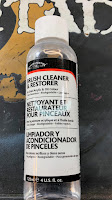*+*+*+*+*+*+*+*+*+*+*+*+*
Begin Transmission
Repetition of General Directive 264-A-XCIV
To: Distribution, Sectorium Primus
From: Office of The Grand Inquisitor, Ebineezar Grinchanius
Re: Yearly Chaos Incursion
This purpose of this notice is to remind the forgetful of the annual visitation by the minion of Chaos known to the unworthy as Santa Claus.
+++ The Emperor's Light Banishes the Shadows of Heresy +++
As the diligent will recall, the incursion occurs regularly every 8742 to
8766 Terran hours, roughly corresponding to a Terran year. This trespass has
occurred with disturbing regularity since at least the Horus Heresy, and
perhaps longer, as many records were misplaced.
+++ Love and Obey the Emperor +++
The faithful will recognize the target on sight, as his garb and gear mark
him immediately as an agent of the abominations.
Santa Claus is a corpulent, bloated creature approximating the human form.
It wears a crimson tunic the color of fresh blood, marking him as a possible
follower of Khorne. It is bearded, mocking the honorable Squats, and its
hair is a sallow shade of gray, betraying its unnatural age. Be advised that
despite the creatures fearsome name, no claws have been observed, and the
former is likely a ruse.
The target has been observed in the company of smaller creatures having the
appearance of thin (less than 30 kg, approx.), stunted (1.5 meters)
humanoids with pointed ears. Their appearance suggests the involvement of
the decadent panzee, and although that race denies involvement (*reference
the Rudolphian Campaign [index 4111-BGE-MMXCII-Primus], specifically the
Battle of Yukon Coneliaus IV [ibid., index 6]*), agents are advised to be
prepared for their involvement, as the panzee are known for their deceitful
ways.
Santa Claus is conveyed by means of a grav-sled powered by unnatural
livestock as detailed below.
The target's vehicle is a grav-sled. It has superfluous runners which are
used only on landing and take-off. Despite the appearance, no frozen water
is necessary for its operation (another ruse). The vehicle's resemblance to
the foul Palanquin of Nurgle should not be discounted, even though the
colors continue to be reminiscent of Khorne.
The device is powered by the unholy ministrations of eight or nine
quadrupeds. Ordo Malleus scholars have identified these creatures as warped
versions of an extinct species of Terran mammal known as a Moose (reference
900002-ER-CIV). These beings single-mindedly pull the target's vehicle
during its yearly invasion. They are outfitted with belled harnesses which
are apparently imbued with the ability of flight. These beasts have been
likened to the Fiends of Slaanesh, and such a comparison should not be
dismissed too lightly, as the creatures shed a luminous substance as
effluent as they move. Inquisitors should take care to avoid exposure.
Perhaps more disturbing is the variable number of the minion-creatures. On
occasion, a ninth Moose has been observed, placed before the other Mooses.
This creature radiates a sickly reddish glow from its snout, as a psychic
beacon to other followers of the Vile Ones. This Chaotic device has allowed
the target to navigate despite our best efforts to jam its navigation
systems.
+++ Blessed is the Virtue of Blind Faith +++
Santa Claus gains entry to the domiciles of loyal Imperial Citizens (see
below) and leaves small Chaos Rewards to tempt the faithful.
Inquisitors are reminded to confiscate and incinerate these items before any
lasting damage is done. As a localized temporal distortion field is in
effect around the target, these items are secreted in the habitations of the
Imperium at exactly 2400 hours in every location defiled by the creature. It
is therefore possible to gain entry to the citizens' quarters and remove the
items (often cunningly hidden in footwear) before the citizens are aware of
the heresy that has been committed upon them.
In other cases, removal of the items after the citizens have discovered them
is possible. In such situations, small children are occasionally loath to
surrender the items, as the tainting of the juveniles has already begun.
Executions of the above are to be handled in the most expedient manner
possible.
Often, juveniles that are well within the Emperor's Grace are given small
blocks of graphite ore rather than the more tempting gifts visited upon the
less faithful. The identity of these individuals are to be recorded, as
future recruitment into the Inquisition or Adeptus Terra is possible [Note:
Inquisitors or other agents who do *not* receive the graphite stones should
be watched carefully].
Santa Claus enters the domiciles be way of heating ducts and waste vents.
The size of the opening is not a factor, as the creature can adjust its mass
and displacement by means of psychic manipulation. Mining these openings
with frag, krak and other demolitions has proven unsuccessful.
The creature egresses by the same means, after ritually caressing his
nostrils. No mucus has ever been recovered.
+++ The Death of Emperor's Enemies is the Only Gift We Can Give +++
Although all previous attempts at the destruction of Santa Claus have
failed, Inquisitors are urged to make such an attempt whenever possible.
However, of more importance is the suppression of cultist activity
associated with the yearly incursion. The Tainted have been known to erect
shrines in their homes in the form of shrubbery adorned with baubles and
lights [Note: the shrubbery is often highly inflammable, and offers a
discrete method of executing the offending heretics without calling undue
attention to the operation].
Other warning signs include:
Hallucinations involving sugared candies during slumber;
Excessive singing;
References to "a magical time of year" (note the influence of Tzeentch);
The construction of effigies made of snow; and
The performance of Slaanishi rituals while underneath plant clippings of the
genus Phoradendron flavescens.
Once again, executions should be handled in an expedient manner.
+++The Emperor Protects+++
End Transmission
*+*+*+*+*+*+*+*+*+*+*+*+*



















